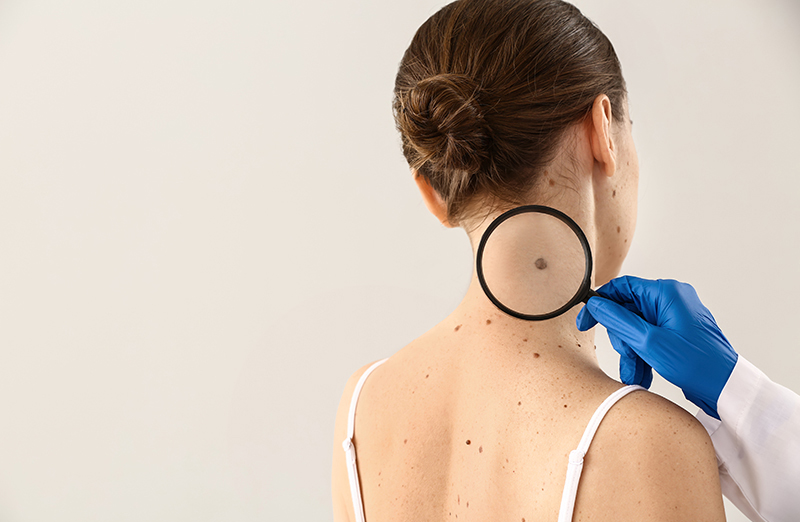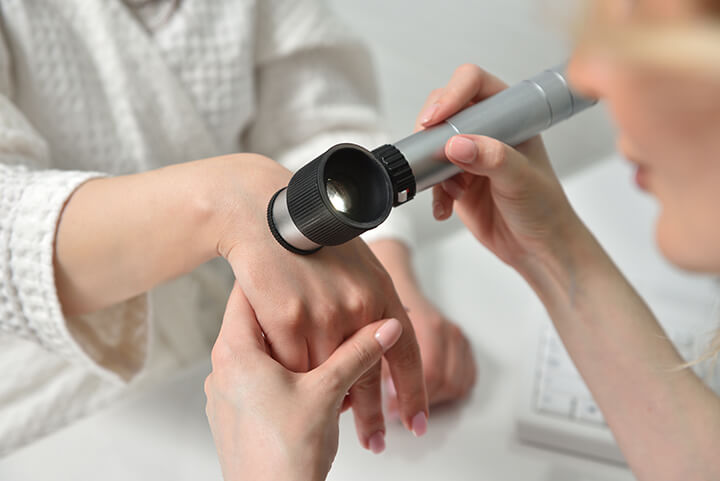
Detecting melanoma: why spotting melanoma early is so important
Our skin needs care during this hot summer, which has been one of the hottest ever recorded.
Part of looking after your skin is being on the lookout for melanoma. This is especially important on the Sunshine Coast, where melanoma rates are significantly high.
The consequences of not detecting and treating melanoma can be devastating, spreading to other parts of the body and resulting in severe illness or death.
As well as thorough skin checks at SunLife, we offer new ways to detect melanoma, utilising advanced technology and techniques.
What is Melanoma?
Melanoma is a serious and potentially life-threatening form of skin cancer caused by malfunctioning melanocytes, the cells that produce skin pigment. This condition is most often seen in skin that has been exposed to excessive amounts of sunlight over the years, causing sun damage.
What are the risk factors of Melanoma?
Several factors increase the chances of developing melanoma:
- Prolonged exposure to the sun’s harmful UV rays
- Fair-to-olive skin types
- High mole count
- Family history of melanoma
However, it’s important to note that melanoma can occur in anyone, regardless of these factors. While it is more commonly diagnosed in older individuals, no age group is exempt from its reach. Thankfully, it’s relatively rare to find melanoma in patients under the age of 20.
Reducing melanoma risk

Reducing the risk of melanoma is a key aspect of our mission at SunLife. We encourage everyone to practice sun-safe habits, such as wearing sun-safe protective clothing, using sunscreen with a high SPF, seeking shade during peak sun hours, and avoiding tanning beds. By taking these precautions, you can significantly decrease your chances of developing melanoma – and reducing your risk of skin cancer in general.
It’s important to note that protecting yourself from melanoma goes beyond just physical measures. Stay informed about the latest research and advancements in skin cancer prevention and treatment. When it comes to the health and wellbeing of your family, choosing the right skin cancer clinic will empower you to take control of your skin health.
Self examination for melanoma
So, what should you look out for when it comes to melanoma?
Keep an eye on any changes in your skin, such as the appearance of new moles or growths, or changes in existing ones. Pay attention to the SCAN rule:
- Sore
- Changing
- Abnormal
- New
- And not going away after 5 weeks.
If you notice any of these warning signs, consult your skin cancer doctor or GP right away.
How do you detect Melanoma?

Melanoma can be detected when you recognise a SCAN lesion, at a skin check where patterns of melanoma can be seen with a dermatoscope, or on imaging where changes are seen with monitoring. It is believed that about 30% of melanomas are diagnosed because of change alone, not because they look like melanoma.
One of the most comprehensive melanoma detection options available is the Vectra 3D Imaging machine with total body photography. This innovative imaging machine captures detailed images of the entire body, providing a comprehensive view of potentially cancerous lesions. But we don’t rely on technology alone. Visual inspection with a dermatoscope by a trained and experienced skin cancer doctor is another important part of melanoma detection.
Each patient’s risk is unique, and a thorough and comprehensive approach to the early detection of melanoma is essential:
- Detailed full body skin checks with a dermatoscope
- Vectra 3D skin cancer imaging using AI to detect changing lesions
- Personalised melanoma prevention advice
- Comprehensive risk assessment
What happens during an appointment to detect melanoma?

Your experience will vary depending on where you go for a melanoma skin check. If you are visiting SunLife, here’s what you can expect:
During your visit, your doctor will conduct a detailed full body skin check using a dermatoscope. This handheld device allows them to examine your skin with magnification and a special reflection-free light. This shows up patterns the naked eye can’t see and identifies suspicious spots.
In addition to the physical examination, some patients may wish to book an additional imaging service using technology trained with AI in combination with 3D imaging to analyse changing lesions. This cutting-edge technology helps identify potential melanoma at its earliest stages, giving you the best chance for early detection and successful treatment.
Each patient’s risk is unique, which is why a personalised approach to melanoma prevention is the gold standard. Your doctor will provide you with tailored advice on how to protect your skin and reduce your risk of developing melanoma. From sun protection tips to lifestyle modifications, we are here to support you every step of the way.
We also offer comprehensive risk assessments. Your provider will evaluate various factors such as your family history, sun exposure, and skin type to determine your individual risk profile. This information allows us to create a proactive plan to monitor your skin health and catch potential issues early on.
What happens if Melanoma is left untreated?

Melanoma is not to be taken lightly; if left undetected and untreated, it can spread throughout the body, leading to devastating consequences, including death. That’s why early detection is critical.
Untreated melanoma can metastasize and affect vital organs such as the lungs, liver, and brain. This can result in severe complications and a decreased chance of survival.
When melanoma spreads, it becomes much more difficult to treat and control. It can invade nearby tissues and lymph nodes, making it harder to remove surgically. It can travel to distant parts of the body, forming new tumours along the way.
The consequences of untreated melanoma can be catastrophic, which is why we emphasise the importance of regular skin checks and early intervention. By monitoring your skin health and promptly addressing any suspicious moles or lesions, we can catch melanoma in its early stages when it is most treatable.
Melanoma treatment
If melanoma is detected, your provider will support you throughout your melanoma treatment journey. This is likely to include a surgical removal of the melanoma. In advanced cases a tailored treatment plan could be made with referral for targeted therapies, immunotherapies, or a combination of these approaches via a multidisciplinary team.
Remember, early detection saves lives. Don’t hesitate to schedule an appointment for a comprehensive risk assessment and to discuss any concerns you may have.
At SunLife Skin Cancer Care Centre, our mission is to detect melanoma as early as possible, ensuring that you receive the best ongoing care. Don’t wait until it’s too late – schedule your detailed skin check today and take the first step towards a healthier, melanoma-safe future.
